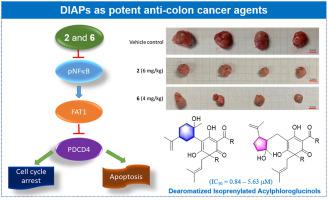European Journal of Medicinal Chemistry ( IF 6.0 ) Pub Date : 2022-06-14 , DOI: 10.1016/j.ejmech.2022.114532 Na-Na Jiang 1 , Grace Gar-Lee Yue 2 , Peng Li 3 , Yan-Song Ye 4 , Adele Joyce Gomes 3 , Frankie Hin-Fai Kwok 2 , Julia Kin-Ming Lee 2 , Si Gao 2 , Clara Bik-San Lau 2 , Gang Xu 4

|
Dearomatized isoprenylated acylphloroglucinols (DIAPs) are specific natural products mainly distributed in the plants of genus Hypericum. In this study, guided by HPLC-UV screening, 46 DIAPs (approximately 70% of all DIAPs) including 20 new ones and an unprecedented architecture, were discovered from the roots of Hypericum henryi, which were elucidated by comprehensive spectroscopic, X-ray crystallography, and ECD methods. Compounds 1–7, 39, and 41–42 exhibited remarkable cytotoxicities (IC50 = 0.84–5.63 μM) in human colon cancer HCT116 cells, in which 2 and 6 possessed selective cytotoxicities towards colon cancer cells. The preliminary structure-activity relationships of these tested compounds were discussed. In addition, mechanistic investigations demonstrated that 2 and 6 could significantly suppress the expressions of NFκB, FAT1, and promoted novel tumor suppressor gene PDCD4 in HCT116 cells. Furthermore, in HCT116 colon xenograft-bearing mouse model, treatments with 2 and 6 reduced the growth of xenograft tumors in dose-dependent manner. Expressions of FAT1 in tumors were also decreased in mice treated with 2 and 6, suggesting their anti-tumor effects were via FAT1 signaling pathway. In conclusion, this is the first report on the mechanistic and in vivo studies of DIAP, indicating that these metabolites can be considered as a new type of anti-colon cancer lead agents for further drug development.
中文翻译:

通过抑制 NFκB-FAT1-PDCD4 信号激活在小鼠中发现具有结肠肿瘤抑制活性的去芳构化异戊二烯化酰基间苯三酚
脱芳构化异戊二烯酰基间苯三酚(DIAPs)是主要分布于金丝桃属植物中的特定天然产物。在这项研究中,在 HPLC-UV 筛选的指导下,从金丝桃的根部发现了 46 个 DIAP(约占所有 DIAP 的 70%),其中包括 20 个新的和前所未有的结构,并通过综合光谱学、X 射线晶体学进行了阐明, 和 ECD 方法。化合物1 – 7、39和41 – 42 在人结肠癌 HCT116 细胞中表现出显着的细胞毒性 (IC 50 = 0.84–5.63 μM),其中2和6对结肠癌细胞具有选择性细胞毒性。讨论了这些测试化合物的初步构效关系。此外,机制研究表明,2和6可以显着抑制HCT116细胞中NFκB、FAT1的表达,并促进新型抑癌基因PDCD4的表达。此外,在荷有 HCT116 结肠异种移植物的小鼠模型中,用2和6处理以剂量依赖性方式减少了异种移植物肿瘤的生长。在用2和6治疗的小鼠中,肿瘤中 FAT1 的表达也降低了,表明它们的抗肿瘤作用是通过 FAT1 信号通路。总之,这是关于 DIAP 的机制和体内研究的第一份报告,表明这些代谢物可以被视为一种新型的抗结肠癌先导剂,用于进一步的药物开发。











































 京公网安备 11010802027423号
京公网安备 11010802027423号